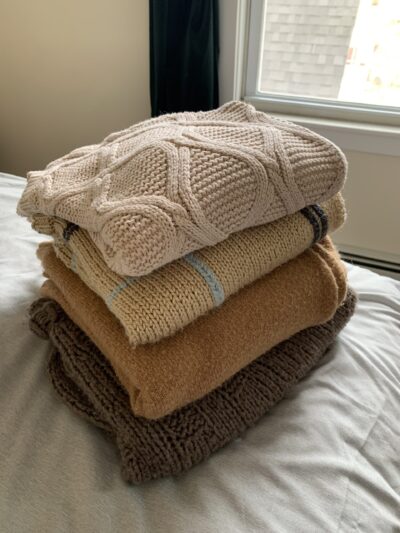When considering what makes fashion truly “ethical,” it’s important to look at the whole creation process from beginning to end, or from seed to garment. That’s a lot to consider! It starts with how the garment is designed, what materials it’s made from and how they’re sourced, and how workers who create the garment are treated.
Note: A ton of this info is from Kate Hall’s first home series. Check out her website for more great content.
Design
- Instead of following the latest trends dictated by the fashion industry and social media, you can choose to opt for more classic styles that you’ll always love.
- Versatile pieces that can be worn in different ways (e.g. as a dress, a top, a beach cover up, etc. or can be dressed up or down for different occasions) give you more options without increasing the size of your closet.
- Consider looking for pieces designed for durability and longevity, like garments that have underarms that hang away from the body to avoid stains and odors, or ones that avoid elements like zippers that may need repairs. Seamless construction tends to be more durable and also reduces the amount of off-cut waste during the creation process.
Materials
- Some materials (even natural ones, like cotton) can be very resource-intensive to grow or create.
- Most synthetic materials can hold odors more easily than natural ones and require more washes, which tends to degrade the garment faster.
- Each time a garment is washed, tiny fibers are released into the water. If the fibers are synthetic, they won’t break down – at least, not for thousands of years, if not longer. These tiny particles get into the water system and end up in the oceans, in marine wildlife, and ultimately in humans.
- Fabric made from mixed materials is usually impossible to separate. Consider where the garment is going to end up at the end of its lifetime. Would it be easy to recycle it?
Construction & Labor
- Many hands touch a garment before it lands on a hanger or your doorstep. Someone needs to harvest the natural material or create the synthetic material to form the fabric of the garment. Additional elements like buttons, zippers, ties, etc. need to be made. These pieces need to be shipped to one place and constructed into the final garment.
- Many companies outsource these tasks to other countries where cheap labor is allowed. Workers can be forced into these jobs since it is the best option they have, however they are almost always still faced with low wages and unsafe working conditions.
- The True Cost is a documentary that exposes many of the injustices of the fashion industry and might make you reconsider buying that $8 shirt. It’s available for free on Tubi and is only about an hour long.
Packaging & Shipping
- Consider the emissions produced by shipping materials and finished items all over the globe. How far did the materials need to be shipped to be assembled? How far did the garment need to be shipped to the store or warehouse? How far did it need to be shipped to your door? Is there a more local option?
- Although of course we want to keep garments safe, we can always consider more eco-conscious packaging options. What kind of packaging does the garment come in when it is shipped to the store or to you at home? Can you support brands that are thinking about this and choosing better packing materials?
Retail & Marketing
- Similarly to the importance of ethical treatment for garment factory workers, it’s important for companies to treat their direct employees fairly. How are the employees at the store or warehouse treated?
- You can tell so much about whether or not a company truly cares about ethical fashion and sustainability just through their marketing. How often is the company pushing people to buy new clothes? Do they have 50 “seasons” per year? Are they coming out with something new every week? Regardless of how eco-conscious they claim to be, if they’re still pushing this, they’re not doing a good job.
- Are there always sales and coupon codes encouraging you to buy, buy, buy? Are the prices “too good to be true?” Compare the sale or after-coupon price with the actual cost to make the garment, including all of the factors discussed above (materials, fair wage labor, shipping, profit margin). Does it match up?

